As winter melts into spring, we sample both familiar and overlooked deep-sky treasures in the "empty space" between Gemini and Leo.
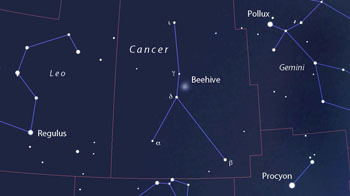
Stellarium
Cancer isn't the first place that comes to mind when you think about rich celestial hunting grounds. To the naked eye there's not much here — a few dim 4th-magnitude stars arranged in an upside-down Y and the soft blur of the Beehive Cluster. Maybe you've hopped right over the crab hurrying from Gemini's star clusters to Leo's galaxies.
Take a few minutes in Cancer next time you have the chance, and you'll find something for every instrument in this transition zone from winter to spring. Within the constellation's bounds are several superb double and multiple stars, two bright, rich star clusters, one of the largest planetary nebulae in the sky, and an assortment of galaxies including a few hidden behind the Beehive.
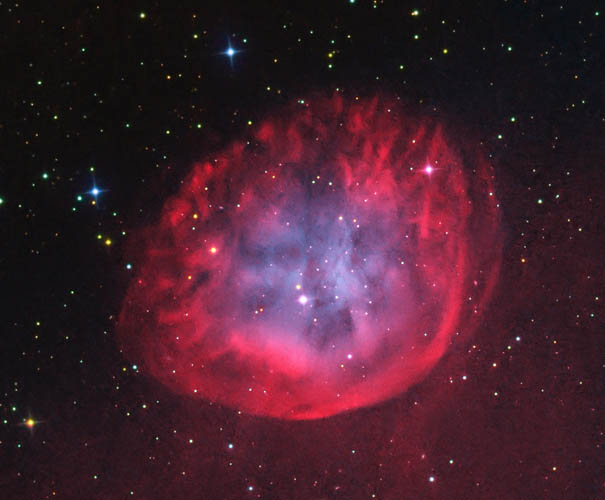
Don Goldman
I've always been intrigued by planetary nebulae, so our travels in Cancer begin with Abell 31, one of the largest planetaries in the sky. At 16.8′ (arcminutes) across, it's about two-thirds as large as the better known Helix Nebula but much fainter at magnitude 12. Given its size, low magnification and a wide field of view work best. In my 15-inch Dob at 64× I suspected a very faint glow at the position without using a nebula filter, but my eyes were much happier with an O III filter in place.
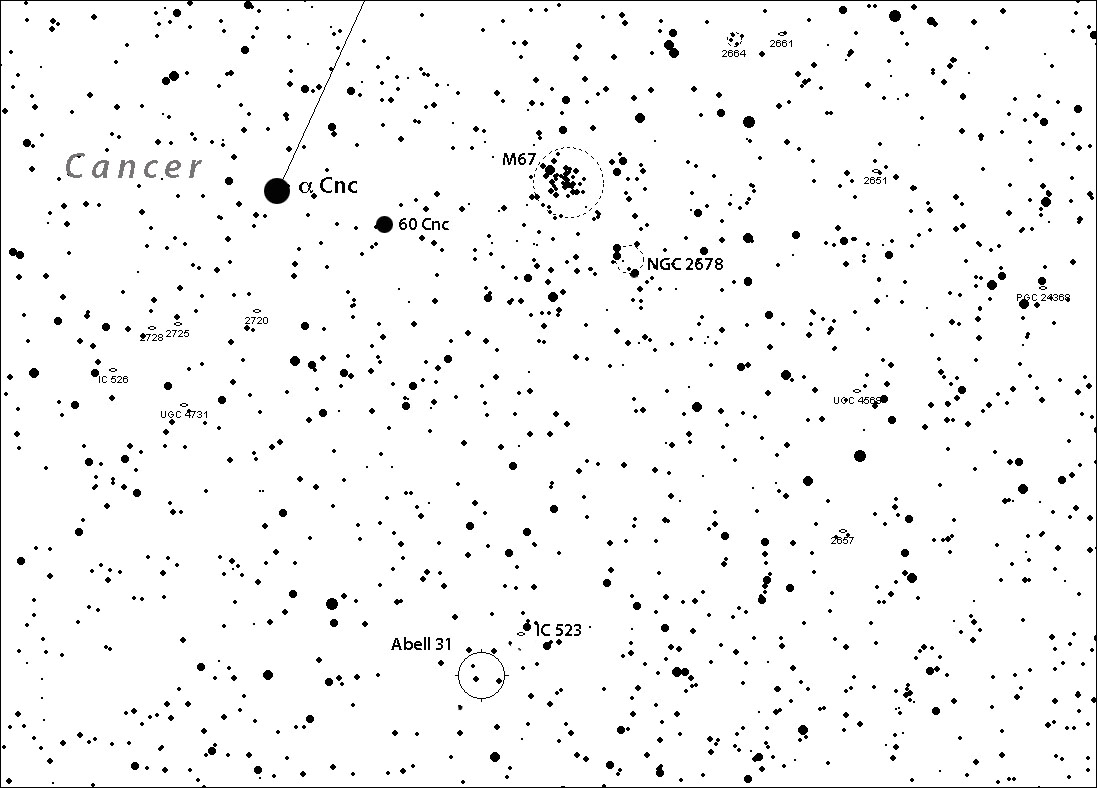
Chris Marriott's SkyMap
I easily saw a puffy haze about 12′ across that looked a lot like the current Comet Iwamoto (C/2018 Y1). The central region and brightest part of Abell 31 is framed by two 10th-magnitude stars on an east-west line 8′ apart. I suspect it would be visible in scopes as small as 8-inches as long as your field of view is at least a degree.
Before you depart Abell 31, owners of 12-inch and larger instruments can torture their eyes on IC 253, a 14th-magnitude galaxy located just 21′ northwest of the planetary. Using 245× I spotted an 1′-long fat, misty streak elongated north-south. Whenever I see these isolated, faint galaxies I wonder who might have been the last person to stop by for a look. Hello in there!
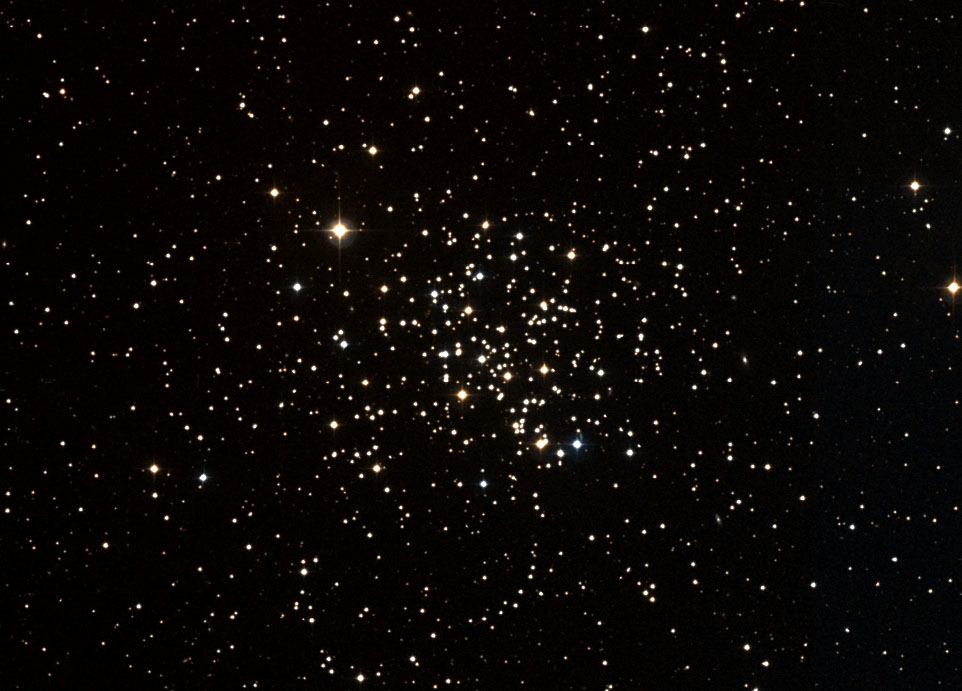
DSS2
Next, we zoom 3° north-northwest and revel in the rich, sparkly open cluster M67. Even my 9×50 finder resolves a couple dozen stars. No matter what scope you use you'll love the view. M67 contains more than 300 stars spread across an area equal to the full moon. At 64× its brightest member, 8th-magnitude SAO 98178, seems to pin the east side of the cluster to the sky. From here, rivulets of stars twist and flow to the southwest like a braided glacial stream. A most beautiful object that sometimes get overlooked in favor of the Beehive to its north.
Born about 4 billion years ago, M67 is one of the most ancient open clusters. Most only survive for a few hundred million years. M67's longevity is due in part to its location well above the galactic plane, where it's shielded from the tidal forces induced by massive molecular clouds in the disk. Its members resemble our Sun in both age and composition leading some astronomers to suggest it may have been the Sun's birthplace.
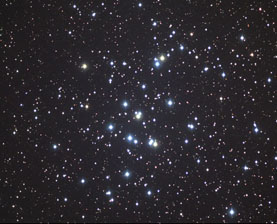
NOAO
A much smaller open cluster, NGC 2678, lies 35′ southwest of the center of M67, at least as plotted in most star atlases. At the exact location, nothing is visible, but there are several stars of magnitude 9 to 11 just northeast of that location. Is it a true cluster? My "bible", Star Clusters by Archinal and Hynes, lists it as an asterism, and I would tend to agree. What do you see?
M44 throbs at the heart of the Crab, and it's unmistakable from a dark sky, where it looks like a luminous cocoon more than 1.5° across. Although its brightest stars shine around magnitude 6, I can only make out the cluster's granulated texture without optical aid. Binoculars and small telescopes offer the best views because their fields of view are wide enough to frame it in dark sky.
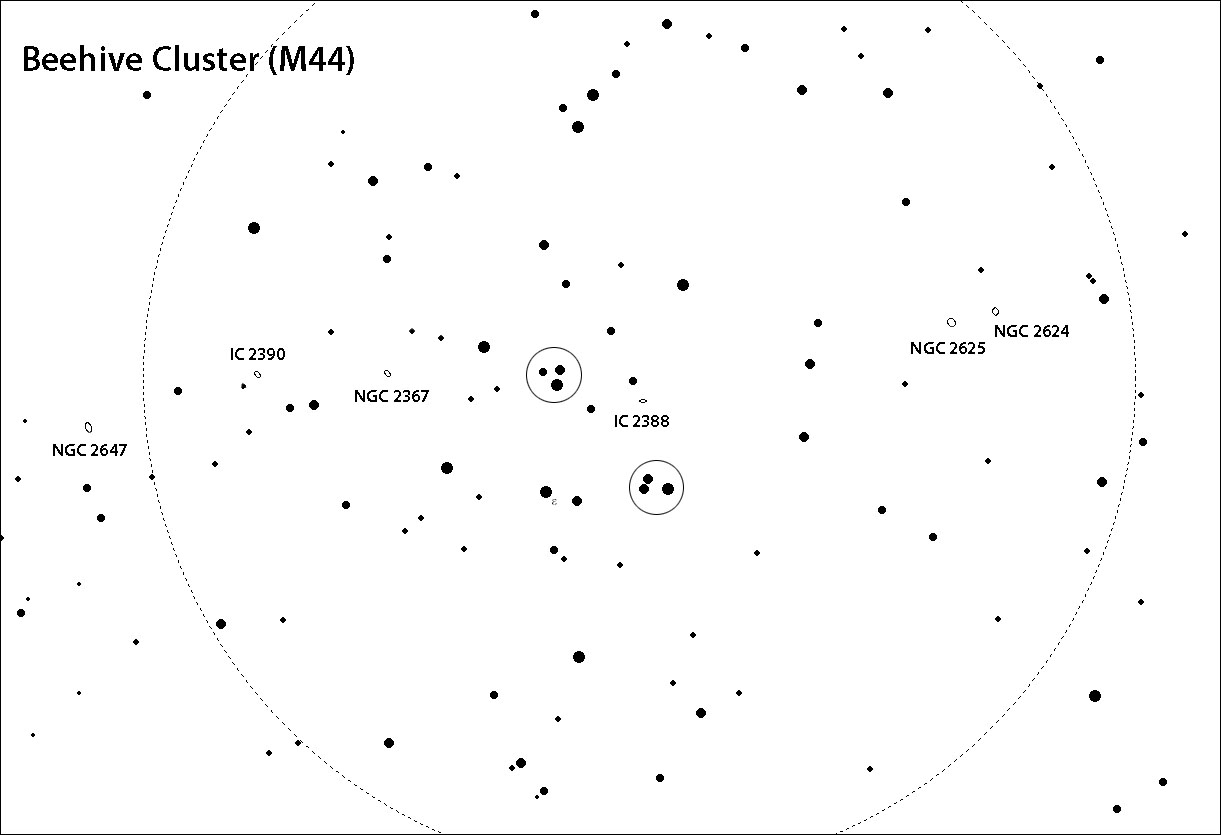
Chris Marriott's SkyMap
There are officially about 1,000 "bees" in the hive, the majority of which are red dwarfs. At low magnification in the 15-inch, the cluster's too big for a good view, but the grid-like layout of the core reminds me of city lights seen from an airplane window on landing and takeoff.
Millions of light-years behind the cluster but doing their best to blend in, you'll find a popcorn string of faint,14th-magnitude galaxies. At least there are lots of stars to help find them! I spotted four of these fuzzies, each 0.5′–0.8′ long using 242× magnification: NGC 2624 paired with NGC 2625, NGC 2637 and NGC 2647. NGC 2624, the brightest, was a classic, round fuzzball with a brighter core, while its tinier neighbor (~15″ wide) to the east appeared quite faint and yet still revealed a stellar nucleus. NGC 2637 proved the most difficult in part because of several bright stars nearby. I saw only a faint haze with little condensation. NGC 2467 was also easy to spy with a brighter central region dotted with faint, stellar nucleus.
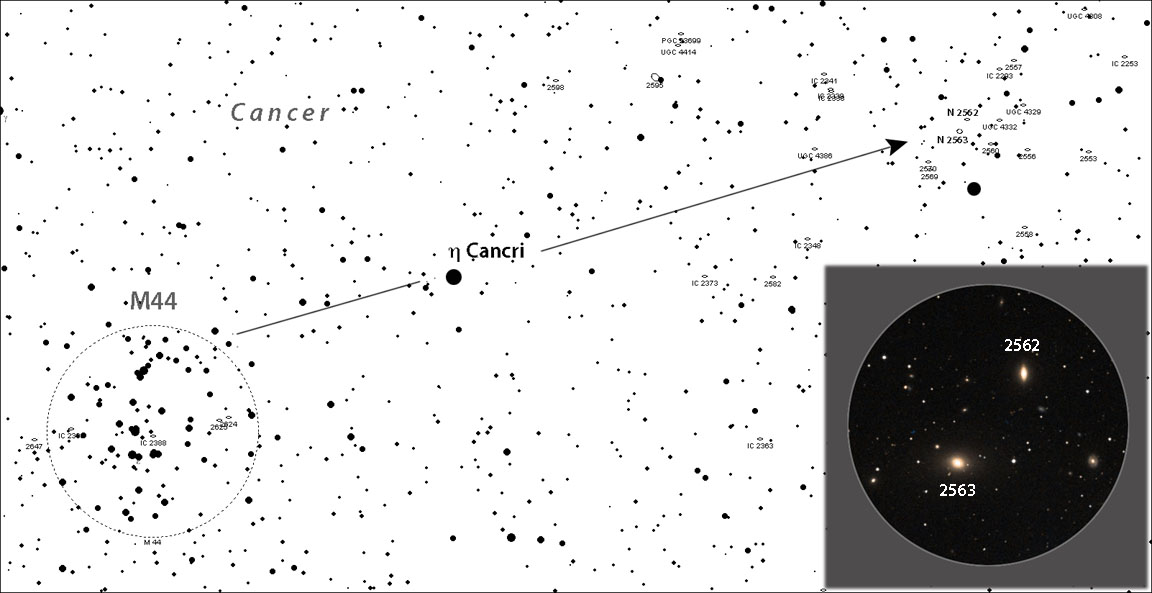
Chris Marriott's SkyMap / Inset: DSS2
From M44, nudge your scope about 5° northwest and you'll run into the core of the Cancer Cluster of galaxies, first described by American astronomer Fritz Zwicky. Located about 30 million light-years away, its members number about 300 galaxies and are spread across 7° of sky. Most are extremely faint, but two stand out boldly just 5′ apart in the core region: NGC 2562 (magnitude 13) and NGC 2563 ( magnitude 12.4). Both are lenticular galaxies and easy to spot at 64×. Even these small objects disclose a few details if you take a minute to examine them at higher powers. At 242× I could see that NGC 2562 was tipped north-south and displayed a bright, near-stellar nucleus. NGC 2563 appeared extended east-west with an even brighter near-stellar nucleus. If you have some extra time, there are additional galaxies in the area, some as bright as 12th magnitude!
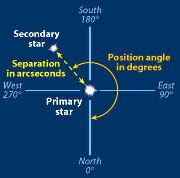
We'll finish up with some of Cancer's brightest and prettiest sights — three double stars and one triple. Each is stunning, so be sure to track them all down at your next opportunity:
Iota (ι) Cancri — (magnitudes. 4.1 and 6.0, separation 31″, P.A. 308° (2016): One of winter-spring's finest doubles. On par with Albireo and makes a great public showpiece. The primary is orange and the secondary seemingly pale blue due to color contrast. In truth the secondary is white, but you don't have to let on. Before you leave, look a ½° to its southwest for a double treat, the pair Σ1266 (8.8, 10.0, 23″ and P.A. 65° (2003).
Zeta (ζ) Cancri triple — (A–C components, mags. 5.3 and 6.2, sep. 5.8″, P.A. 66° (2017) / A-B components, mags. 5.3 and 6.3, sep. 1.0″, P.A. 9° (2017): A lovely duo if you're using lower magnification, but in good conditions, jack it up to 250×–300×, and you'll love what you'll see. The primary splits again! A superb triple that rivals Beta (β) Monocerotis. Keep watch on the primary; it's a close binary with a period of just 60 years. It doesn't take but a couple years to see a change in P.A. I split it in a 10-inch but a 6-inch should handle it just as well.
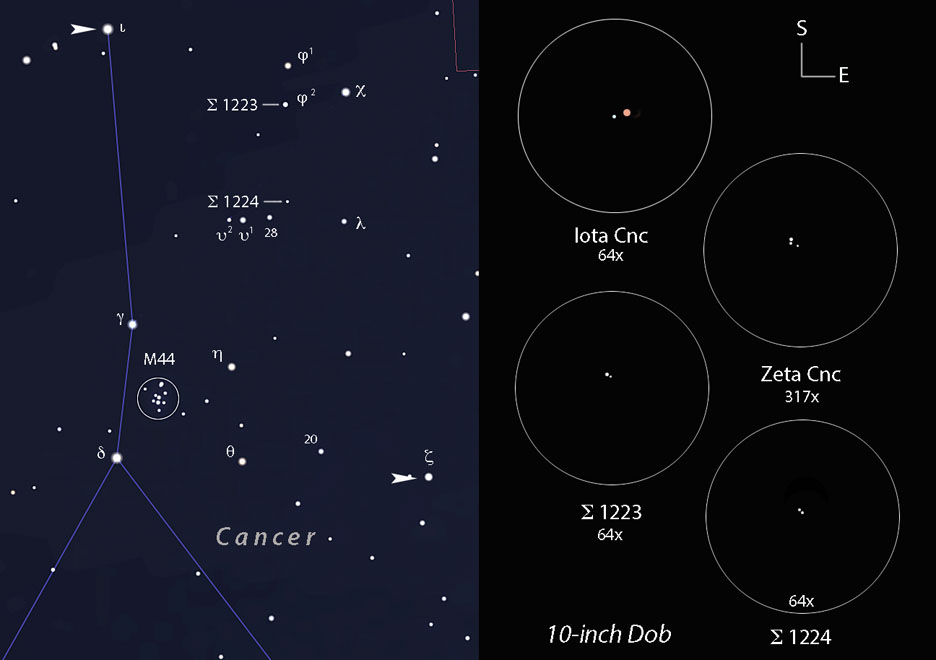
Bob King
Σ1223 = Phi 2 (φ2) Cnc — (mags. 6.9 and 7.5, sep. 5.6″, P.A. 52° (2017): Attractive unequal double. Pleasingly close at 64×.
Σ1224 — (mags. 6.2 and 6.2, sep. 5.2″, P.A. 217° (2017): Outer space eyes staring back. Lovely, equal pair. Delicate.
 5
5








Comments
tom-dasilva
March 13, 2019 at 12:00 pm
Great article! I pretty much take your articles to my scope starting from the top.
You must be logged in to post a comment.
Bob KingPost Author
March 13, 2019 at 2:13 pm
Hi Tom,
I'm honored. Thank you, and I hope you see all the features sky wonders. The moon's starting to edge in a bit, so you may have to put off the fainter ones till after full. Good luck!
You must be logged in to post a comment.
Rod
March 13, 2019 at 2:54 pm
Bob, I was out last night with clear skies here and waxing crescent Moon in Taurus (beautiful evening). I used my 10-inch and enjoyed the view of M67 in Cancer-very much. I was also out viewing some galaxies in Leo and later, M51 the Whirlpool with its companion. The geese are moving north now in my area along the Patuxent farms. [Shortly after 2100 EDT, very loud and noisy migrating geese flocks flew over head of my south pasture heading north for the spring and summer. The waxing crescent Moon in W sky in Taurus was lower. The geese flying at night might be using star navigation back to their spring nesting and summer grounds. I was using star navigation while viewing with my telescope 🙂 There were different flocks that continued to fly by honking loudly in their migration.]
You must be logged in to post a comment.
Bob KingPost Author
March 13, 2019 at 7:20 pm
Rod,
Beautiful description of the evening. We're all geese in this world.
You must be logged in to post a comment.
Florin Tiran
March 18, 2019 at 11:19 am
Thanks Bob! It's an amazing walk through this constellation. I've always enjoyed M44 and M67 but I had no idea of that Abell 31 planetary nebula. I'm curious if I'd have any chance of finding it in a 10" dob. Most likely not, I'll wait for the opportunity to use at least a 12" or larger scope on a star party. Anyway, even star hopping (https://www.astroapprentice.com/2019/03/13/star-hopping-to-deep-sky-objects-dsos/) and actually finding that object seems like a hard task.
You must be logged in to post a comment.
You must be logged in to post a comment.